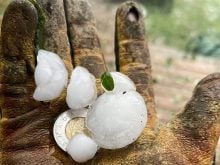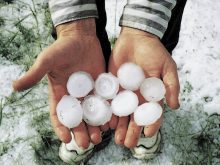A storm that hit Aug. 21 is expected to account for nearly two-thirds of all August hail claims made in the province
Prairie harvest was partially performed by Mother Nature’s combine this fall when hailstorms hit various regions.
The Canadian Crop Hail Association reported Sept. 6 that more than one million acres were damaged by hail and strong winds between Aug. 19 and 25. Damaging storms also occurred from Aug. 12 to 18, resulting in 1,340 claims, and storms from July 19 to Aug. 11 resulted in 1,642 claims.
“This was one of our busiest weeks, with multiple storms producing hail of all sizes, accompanied by big winds,” said CCHA president Scott McQueen, in a news release.
Read Also

Producer profits remain under significant pressure
Manitoba farmers are facing down a double hit of high input costs, like fertilizer, and low grain prices as they harvest their next crop.
Saskatchewan faced the worst of it in two storm systems, one across the north-central region moving eastward from North Battleford, and the second moving northeast from the U.S. border to Regina and Estevan.
Hail season is typically late June to early August so the storm dates were unusual.
“In a normal hail season, you see lesser and lesser events of hail as you get into August, September,” said Rodney Schoettler, chief executive officer of Saskatchewan Municipal Hail. “And this storm, on Aug. 21, was kind of an outlier in the sense that it was so big. So, on Aug. 21, our office alone has claims on 430,000 acres.”
Schoettler said he expects that day will account for nearly two-thirds of all August hail claims in Saskatchewan.
Rosthern, Sask., farmer Louis Perrin experienced the storm first hand.
“It moved so fast, we couldn’t believe it,” he said.
The Perrins were just finishing pea harvest near Rosthern on a 60-bushel crop they expected to finish on the night of Aug. 21 but the storm hit at about 5 p.m.
“It was on us, just like that. And visibility was maybe 500 feet, where it was raining and hailing so hard — it was something I’d never experienced before.”
Their yield in that field dropped to about seven bu. per acre. Nearby wheat fields were also decimated and one field north of Rosthern was flattened.
“It never seems to matter whether it’s a quarter or whether it’s half or whether it’s just one field. You just hate to get hailed on, you know? And it doesn’t seem to matter what you do.”
Perrin estimates about a third of their 8,000 acres were hit by golf-ball sized hail. The storm path was about three kilometres wide.
Now their worry is volunteer grain and straw management.
“This straw is so, so flat and so down that we’re not able to harvest and do our straw management like we normally would. So we have to come up with some way of dealing with all this straw that is just so attached to the ground right now.”
Heavy harrows may not be enough and they may resort to discing, which isn’t ideal for their no-till operation.
Elsewhere on the Prairies, Manitoba and Alberta crops also suffered hail damage last month.
A strong system came through the area west of Brandon on Aug. 18, affecting Virden, Elkhorn, Russell, Roblin, Solsgirth, Birtle, Two Creeks, Hargrave, Maples and Harmsworth.
Severity ranged from minor damage to entire writeoffs, affecting 83,000 acres in the area.
That storm was followed by severe winds Aug. 21.
Alberta regions had hail Aug. 3 to 5 southeast and northeast of Calgary, creating roughly 1,200 claims on nearly one million acres.
George Kueber, claims adjusting manager for Agricultural Financial Services Corporation, said claims were smaller and more scattered across Alberta.
When it comes to hail, Schoettler said no one can see patterns.
“When you’re in the weather business, we have to ask ourselves what is normal,” he said. “And there really isn’t. We just follow weather patterns, right? They’re all over the map.”
While harvest is rolling and producers are pressed for time, insurance adjusters are calling for patience as they work through claims, especially in Saskatchewan.
“It’s going to take them a little longer than normal, just because it’s so much at once,” said Schoettler.


















